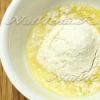Myths and truths about palm oil. Truths and myths about palm oil: the war of fats
In recent years, palm oil has become widely used in Food Industry. For several years, its share in production has increased several times, and there was a lot of talk about the dangers of this product for human health. Myths and misconceptions about palm oil multiply proportionally, but not all statements have any objective basis, and many completely distort scientifically confirmed facts.
Myth 1. The melting point of palm oil is higher than human body temperature.
This myth does not exist on its own, but as an integral part of the main horror story about palm oil. Like, once the product goes into a liquid state at a temperature above the temperature human body, which means that it is not digested and is not completely excreted from the body, remaining in it a plastic sticky mass and clogging the blood vessels.
 Unlike other vegetable oils, palm oil actually initially has a semi-solid consistency and a melting point of 33-39°C. By the way, it is largely due to this consistency that palm oil is considered especially attractive for the confectionery and baking industries. At the temperature of the human body, palm oil almost completely turns into a liquid state, however, the presence of solid fractions at 36.6 ° C does not at all indicate that, once in the human body, the oil remains in it as a “sticky mass”. There are fats that are more familiar to all of us, whose infusibility is much higher than the temperature of the human body, they are used in food and no one is worried that such fats are not excreted from the body. For example, the melting point pork fat reaches 46°C, and beef and lamb exceeds 50°C!
Unlike other vegetable oils, palm oil actually initially has a semi-solid consistency and a melting point of 33-39°C. By the way, it is largely due to this consistency that palm oil is considered especially attractive for the confectionery and baking industries. At the temperature of the human body, palm oil almost completely turns into a liquid state, however, the presence of solid fractions at 36.6 ° C does not at all indicate that, once in the human body, the oil remains in it as a “sticky mass”. There are fats that are more familiar to all of us, whose infusibility is much higher than the temperature of the human body, they are used in food and no one is worried that such fats are not excreted from the body. For example, the melting point pork fat reaches 46°C, and beef and lamb exceeds 50°C!
Unlike animal fats, palm oil does not contain cholesterol, and its absorption rate reaches 96%. This, by the way, is higher than in the case of milk fat, which is absorbed by the human body in best case by 91%.
Myth 2: Palm oil needs to be treated with care, like any new product.
 The consumption of palm oil over the past decades has indeed increased significantly due to its relative cheapness and the increase in oil palm plantations, but this does not mean at all that people did not eat this product before. Palm oil is considered one of the oldest food products known since ancient Egypt!
The consumption of palm oil over the past decades has indeed increased significantly due to its relative cheapness and the increase in oil palm plantations, but this does not mean at all that people did not eat this product before. Palm oil is considered one of the oldest food products known since ancient Egypt!
Palm oil is made from small fruits of oil palms, squeezing it out of the pulp, as is done, for example, with olives. Thus, another myth about palm oil, which says that it is produced from tree trunks, turns out to be untenable.
Myth 3. Palm oil raises blood cholesterol levels.
 As mentioned above, palm oil itself, like other vegetable oils, does not contain cholesterol. However, the presence of palmitic acid in palm oil, according to some studies, can indeed provoke the natural generation of cholesterol in the human body. However, similar fatty acids are also found in other foods, such as cream and butter, meat, eggs, and chocolate. Thus, it is more appropriate to talk about the moderation of consumption of certain products, including palm oil, rather than about the rejection of them. If you do not spread palm oil on bread and do not eat several such sandwiches a day, the danger of a sharp increase in cholesterol levels from this product tends to zero.
As mentioned above, palm oil itself, like other vegetable oils, does not contain cholesterol. However, the presence of palmitic acid in palm oil, according to some studies, can indeed provoke the natural generation of cholesterol in the human body. However, similar fatty acids are also found in other foods, such as cream and butter, meat, eggs, and chocolate. Thus, it is more appropriate to talk about the moderation of consumption of certain products, including palm oil, rather than about the rejection of them. If you do not spread palm oil on bread and do not eat several such sandwiches a day, the danger of a sharp increase in cholesterol levels from this product tends to zero.
On the other hand, palmitic acid is essential for the body and, in particular, is required for the growth and development of children. It is only worth noting that this substance is part of breast milk nursing woman. For this reason, palm oil is found in milk formulas for breastfeeding, which is another myth about this product. You can often hear about the dangers of this ingredient for newborns and that palm oil impairs the absorption of calcium from milk mixtures in the body of a newborn.
 This assertion has some basis. The fact is that the absorption of palmitic acid depends on its location on the fat molecule. It is precisely this property that this substance differs in breast milk and palm oil, so the latter in pure form, indeed, may not be very useful for newborns. However, modern dry mixes use a modified palm oil formula called beta palmitate. In this form, the substance is as close as possible in terms of characteristics to the palmitic acid contained in breast milk.
This assertion has some basis. The fact is that the absorption of palmitic acid depends on its location on the fat molecule. It is precisely this property that this substance differs in breast milk and palm oil, so the latter in pure form, indeed, may not be very useful for newborns. However, modern dry mixes use a modified palm oil formula called beta palmitate. In this form, the substance is as close as possible in terms of characteristics to the palmitic acid contained in breast milk.
Myth 4: Palm oil products are unhealthy.
 The difference between vegetable oils and vegetable fats should be clearly understood. The first are made from plant materials. Unrefined vegetable oils contain vitamins and microelements that are present in the raw material itself: sunflower seeds, olives, soybeans, sesame seeds, flax, etc. Also, the composition of vegetable oils contains a lot of fatty acids, which are extremely useful for maintaining the metabolism in the body. From this point of view, palm oil is no worse than other vegetable oils. Yes, it has fewer polyunsaturated fatty acids useful for the body than, for example, in olive oil. At the same time, in terms of vitamin E content, palm oil is superior to sunflower oil, and the content of vitamin A in liquid red palm oil is higher than in fish oil!
The difference between vegetable oils and vegetable fats should be clearly understood. The first are made from plant materials. Unrefined vegetable oils contain vitamins and microelements that are present in the raw material itself: sunflower seeds, olives, soybeans, sesame seeds, flax, etc. Also, the composition of vegetable oils contains a lot of fatty acids, which are extremely useful for maintaining the metabolism in the body. From this point of view, palm oil is no worse than other vegetable oils. Yes, it has fewer polyunsaturated fatty acids useful for the body than, for example, in olive oil. At the same time, in terms of vitamin E content, palm oil is superior to sunflower oil, and the content of vitamin A in liquid red palm oil is higher than in fish oil!
 As for vegetable fats, then everything is not so simple. Despite the fact that they are made from vegetable oils, not all the useful properties of the latter are by default found in the new product. The reason for this is the way it is made. vegetable fat. In the process of hydrogenation, so-called trans fats are formed in the oil, which make a solid mass from an initially liquid product. Trans fats are poorly absorbed by the body, raising total cholesterol levels. For this reason, taking care of your health, you should pay attention to the content of vegetable fats in the composition of the product and, if possible, refuse to use them. Not to mention the use of pure vegetable fat in the form of spreads and margarines.
As for vegetable fats, then everything is not so simple. Despite the fact that they are made from vegetable oils, not all the useful properties of the latter are by default found in the new product. The reason for this is the way it is made. vegetable fat. In the process of hydrogenation, so-called trans fats are formed in the oil, which make a solid mass from an initially liquid product. Trans fats are poorly absorbed by the body, raising total cholesterol levels. For this reason, taking care of your health, you should pay attention to the content of vegetable fats in the composition of the product and, if possible, refuse to use them. Not to mention the use of pure vegetable fat in the form of spreads and margarines.
What foods can contain palm oil:
- confectionery, chocolate, cookies, waffles
- bakery products, pastries
- dairy and dairy products, cheeses
- powdered infant formula
Myth 5. Palm oil contains carcinogens.
Confirmed scientific research there is no evidence for the presence of carcinogens in palm oil. Like any other vegetable oil v fresh it is absolutely safe from this point of view. However, with repeated heat treatment in vegetable oils, indeed, carcinogens can form. This is typical not only for the relatively exotic palm oil, but also for the usual sunflower oil. In this regard, you should simply take less oil when frying, abandon it reuse and be careful with deep frying.
 Speaking about the development of cancer, it is also worth mentioning that a large number of fat in food basically increases the risk of developing tumors. This again does not mean that you need to completely abandon the consumption of fatty and fried foods, but reducing the number of such foods in your diet will not be harmful to anyone.
Speaking about the development of cancer, it is also worth mentioning that a large number of fat in food basically increases the risk of developing tumors. This again does not mean that you need to completely abandon the consumption of fatty and fried foods, but reducing the number of such foods in your diet will not be harmful to anyone.
A large number of myths about palm oil and their widespread occurrence can be associated with several factors at once. First, in most cases people have a poor understanding of the principles metabolic processes in the body and are little informed about the real properties of certain products. Therefore, when there are unsupported loud statements about the dangers of some products, they are immediately picked up by rumors and passed from mouth to mouth, acquiring more and more monstrous details. Secondly, the significant increase in palm oil production in recent years and the scale of its use in the food industry may force producers of other vegetable oils to deliberately disseminate false information in order to discredit a direct competitor of their product.
If you pay attention to product labels, you will often come across an ingredient such as palm oil. Today, this product has acquired a large number of myths and is the subject of many disputes around the world. Those who adhere healthy eating claim that it is harmful to health. There are even laws being passed banning its use in food. Let's figure out whether palm oil is actually useful or harmful.
Palm oil belongs to vegetable oils and among all vegetable oils it is the only solid one. This product is not derived from palm stems as some claim it is made from the pulp of the fruit oil palm. There is also palm kernel oil, which is made from the seeds of this plant. Palm fruit oil is actively used in the production of confectionery, mayonnaise, cheese, condensed milk, butter, chips, etc., as it significantly lengthens the shelf life of products.
Palm kernel oil can be found in cosmetics, soaps, and ointment bases. And this makes sense: for example, in soap, palm kernel oil increases its foaming, prevents cracking and makes it plastic.
Palm oil is readily available and its production does not require large financial investments.
In a global sense, this availability and cheapness of oil leads to serious problems: in order to increase its production, tropical forests are cut down and oil palm fields appear on the liberated lands. Such deforestation leads to the death of rare species of animals, which harms the entire ecosystem of the planet.
Palm oil is often said to be harmful based on its melting point, which can range from 19°C to 54°C. And since the temperature of the human body is lower than the melting point of the oil, it is argued that it does not dissolve in the body, is not excreted and is deposited on the vascular walls in the form of cholesterol plaques.
However, many scientists are convinced that the human body does not experience any problems with the digestion of oil, especially since natural red oil (as unrefined palm oil is called) begins to melt at t=36°-39°. Another example is pork fat (lard), which does not melt when room temperature and is enjoyed by lovers of this product.
Such a popular myth that palm oil is not digested in the body is dispelled very simply: body temperature is not involved in the digestion of fats, but enzymes and bile are involved.
The benefits of palm oil
This product, which has become so popular today, is in fact one of the most ancient human foods. It was known to the ancient Egyptians. According to excavations, the history of palm oil has more than three thousand years!
In recent years, the production of this type of vegetable oil has surpassed the production of rapeseed, soybean, and all other vegetable oils. Even our popular sunflower oil is produced 2.5 times less than palm oil! And all due to the fact that it is resistant to oxidation and can retain its properties for a long time. "Rancidity" regular oil give unsaturated fats, which are oxidized by reacting with oxygen. Palm oil has a low content of unsaturated fats, which is why it does not oxidize as quickly as other oils.
There is no basis for saying that palm oil is banned in Western countries. In developed countries, it is the most popular vegetable oil.
Heart and vascular health
Red (crude) palm fruit oil is much richer in vitamin E than the same sunflower oil. Vitamin E has antioxidant properties, thanks to which they say beneficial effect palm oil on the brain. Studies show that the tocotrienols (fat-soluble E vitamins) in this product protect brain cells, reduce the risk of stroke, and prevent the progression of dementia (acquired dementia).
Speaking about the benefits and harms of palm oil, it should be noted that this product protects against heart disease, helps lower the level of "bad" cholesterol in the blood and increases the level of "good".

The decrease in blood levels of total cholesterol is due to the linoleic and oleic acids of this oil, whose role in the health of the musculoskeletal system and skin is also extremely high.
Many studies in this area have shown that total cholesterol levels were lower in people who fortified their diet with palm oil than in those whose diet was high in trans fats.
A study was also conducted, according to which one group of subjects consumed 2 tbsp daily. palm oil, and the other - the same amount olive oil. As a result, the level of "bad" cholesterol (low-density lipoprotein) was reduced by 15%, from which it was concluded that palm oil can be called " tropical olive oil equivalent»…
Excellent source of vitamin A
Palm oil is much superior in carotenoid content to other vegetable oils and even fish fat. And in general, it is the leader in the content of carotenes and their derivatives among the rest. herbal products. According to studies, the rich content of carotene in this oil reduces the risk of developing cancer.
With a lack of vitamin A, this product will help increase the content of this substance in the blood of both adults and children. Therefore, it can be safely used for the prevention of hypovitaminosis.
Carotenoids are powerful antioxidants that improve the condition of the skin and hair. Because this oil is so fond of using cosmetic companies.
Use of palm oil
The main scope of this product is the food industry. It is found in waffles, biscuits, creams, cakes, processed cheese, hard cheeses, cottage cheese desserts, condensed milk, sweets, butter, lollipops, margarine and even cottage cheese. Semi-finished products are still fried on it. To some extent, they replace milk fat. Palm oil is cheaper raw milk! It's harder to find products that don't contain it than those that do.
Palm oil is found in candles and soaps, in cosmetics ah, used for dry skin of the face, as well as for skin prone to aging - this ingredient helps to nourish, moisturize and soften the skin.

The healing effect of palm oil is not limited cardiovascular system, it helps with a wide variety of diseases of the organs of vision.
Fats (triglycerides) of palm oil are quickly digested by the body and are involved in energy production. Therefore, this product is recommended for athletes and those who have problems digesting other fats.
Of course, the beneficial properties of this product cannot but rejoice, but everything has a downside.
Palm oil is used in the process of preparing fast food - the same fried potatoes fries. This oil enhances the taste of food, making consumers want to buy such food again and again. In addition, deep-fried oil rarely changes, think next time if you should buy such food?
A study conducted on rats showed that repeated heating of palm oil reduces its antioxidant properties and increases the risk of cholesterol plaques sticking to the vascular walls. When rats ate foods containing 10 times hot palm oil for six months, they developed more cholesterol plaques and other signs of heart disease than rats eating foods with fresh palm oil.
Harm of palm oil: potential risks
Although, as it turns out, this product has a lot useful properties, it is the high content of saturated fats in it that can harm health. These saturated fats are also found in butter, making it potentially hazardous to our health. It is often heard that those who large quantities consume saturated fats, are at risk of acquiring various diseases of cardio-vascular system.
It is not surprising that palm oil causes a lot of controversy and criticism, because its benefits and harms intersect each other: on the one hand, saturated fats in the product increase the level of "bad" cholesterol in the blood and provoke heart disease, but on the other hand, a large amount of vitamin A and E make butter excellent tool Prevention of heart diseases plus also oncological diseases!
Also, although the linoleic acid in palm oil makes it valuable product, but its content in this product is much less than found in other vegetable oils, which means that the dignity of this oil as a source of linoleic acid is controversial.
Such an intersection of harmful and beneficial properties is puzzling, but everything is easily explained: palm oil is divided into several types.

Varieties of palm oil
- Natural red palm oil is among the most useful. All the beneficial properties of palm oil described in the article relate to a greater extent to this type. To obtain it, special technologies are used to preserve the largest number useful substances. To obtain this product, the woody pulp of the palm fruit, located near its stone, is processed. It is in it that all the useful substances are concentrated.
A large amount of carotene in the oil gives it an orange-red color. The smell and taste of the product is pleasantly sweet.
- Oil palm fruit oil in a refined and deodorized form contains much less nutrients. It does not have any smell and color, it is actively used in the food industry.
- The lowest grade palm oil is a product with a low degree of refinement, it contains a large amount of harmful oxidized fats. This variety is used in the production of soaps, cosmetics, etc. Unfortunately, it happens that some unscrupulous manufacturers use this type of oil in food products. The danger of using such products lies in the accumulation of free radicals in the body, the risk of oncology and the formation of cholesterol plaques. Everything related to the harm of palm oil refers specifically to such foods.
Palm oil as a component of baby food
Many manufacturers add palm fruit oil to breast milk substitutes, replacing animal fats with it. cow's milk. Due to the high content of palmitic acid in the oil, this makes the mixture with it closest to mother's milk. After all, it is known that human milk contains palmitic acid.
Careful technological processing raw materials allows to obtain highly purified palm oil, which is not subject to oxidation, therefore, infant formulas with it in the composition remain fresh for a long time and with a long shelf life.
The danger when using formula or other baby foods containing palm oil is the ability to stimulate the appetite. This means that overweight and normal weight children should be given these products with caution.
Besides, clinical researches led to the conclusion that the use of such mixtures provokes stool retention. Therefore, before purchasing a formula for your baby, consult your doctor about whether he should use it if the composition contains palm oil.

Traditional medicine recipes
As I already wrote, the most valuable is red palm oil. It has powerful antioxidant properties, reduces the risk of developing a heart attack and diseases of the organs of vision, stops thrombosis, helps reduce blood pressure, heals, and improves the condition of the liver.
The optimal age for the use of this product is 18-50 years. Dosage - 10 ml per day. Do not heat treat it.
- If you have gout, prepare this healing ointment: mix palm oil (15 ml) with pine and lemon (5 drops each), lavender (10 drops) and grape seeds (25 ml). Rub this ointment into problem areas with massaging movements.
- If you suffer from arthritic pains, prepare this ointment: mix palm oil with (15 ml each), lavender and lemon (3 drops) and pine (5 drops). Apply the ointment with rubbing movements on problem joints.
- If you have cuts or burns on your skin, apply an oil palm product twice a day to problem areas twice a day. The course is two weeks.
- If you have psoriasis, eczema or lichen on your skin, this ointment will help you: mix palm oil (80 ml) with birch tar (3 g) and oil walnuts(20ml). The ointment is distributed over problem areas twice a day. The course is two weeks.
- For cracked nipples due to breastfeeding, warm the oil in a water bath and apply to the nipples after feeding the baby.
- For periodontal disease and inflammatory processes in the mouth, prepare such a compress: soak a sterile bandage in oil and apply it to sore gums. The course is two weeks.
- If you have cervical erosion, soak a cotton swab in slightly warm oil and insert it into your vagina. The procedure is done every other day, the course is ten days. Talk to your doctor about this type of treatment.
What conclusion can we draw? If you have a product containing natural palm oil in your hands, it is quite possible that it will not harm your health, but the benefits from it will be great. Unfortunately, it is quite difficult to determine whether it contains high-quality palm oil? And even if you are sure that the product contains high-quality red palm oil, the main thing is not to convey. Even the most healthiest foods at excessive use are harmful to health.
To protect yourself, try to limit your diet to foods with palm oil and generally give up processed foods and fast food. To do this, learn to determine which products contain palm oil and which do not. This table will help you:
| Product | Does not contain palm oil | Contains palm oil |
| Sour cream | It thickens in the refrigerator, when combined with hot foods, it releases whey | In the refrigerator, it does not thicken and does not change consistency, a feeling of a greasy film appears in the mouth |
| Butter | It melts quickly in the mouth, has a sweetish milky taste, softens when warm, melts in a hot frying pan, leaving a white film and flakes, and completely melts on the palm, forming a whitish film on the skin | Leaves a feeling of viscosity on the teeth and a film on the tongue, remains solid at room temperature, when heated in a pan turns into a liquid without any inclusions, never completely melts in the palm of your hand, leaving small lumps |
| Cottage cheese | Turns sour quickly at room temperature | At room temperature, it is covered with a yellowish crust, does not sour for a long time, retains taste qualities and smell |
| Milk | You can see a layer of cream on the surface | The color is slightly blue when stored out of the refrigerator. for a long time does not spoil |
| Cheese | At room temperature, the dense becomes soft, less elastic and eventually dries out. | It has a soapy taste, sticks to the knife, begins to crumble when cut, hardens at room temperature, oily drops appear on its surface, becomes hard and very windy |
| Ice cream | At room temperature, ice cream will become soft, airy and foamy. | Rubbed in the palm of your hand, you will feel a greasy film, at room temperature it melts for a long time, releasing a clear liquid |
Unexpected facts about palm oil are revealed in this video:
In our country, palm oil has become synonymous with a low-quality, cheap product. Meanwhile, this is one of ancient products nutrition of mankind, known in ancient Egypt.
Palm oil is the most popular vegetable oil on the planet. According to the World Foundation wildlife An estimated 50% percent of packaged foods sold in supermarkets contain palm oil.
Let's go to Southeast Asia and look at the production of palm oil.
The main wholesale buyers of palm oil are corporations such as Nestlé and Unilever. In addition to food, palm oil is used to produce biofuels, cosmetics, shampoos and many other biochemical products. Every day they need more and more oil. Where to take it?
It's very simple: thousands of square kilometers of forests and peatlands in Southeast Asia are being destroyed to make way for palm plantations.
Here we just see the barbaric formation of an oil palm plantation. In the foreground - new plantings of oil palms on the site of the destroyed forest, behind - the destruction of the forest for new plantations.
In the background - endless planting of oil palms, in front - the destruction of the forest for new plantations.
To destroy forests, they are simply set on fire. This is Indonesia.
It should be noted that due to its incredible productivity, the oil palm allows the most economical use of land for the production of vegetable oil. It takes 2 hectares of land to produce one ton of sunflower oil. Palm plantations allow you to produce more than 7 tons of vegetable oil from the same area.
There are only 14,000 orangutans left in Sumatra. The reasons for the extinction of the species are poaching and the destruction of their habitats. Destroyed habitat habitats of intelligent monkeys that live mainly in trees. The culprit is the oil palm.
In Indonesia, there are even rehabilitation centers for these smart monkeys before they are released back into the wild.
Here they are, the fruits of the oil palm. Palm oil has surpassed production since 2015 soybean oil, rapeseed oil and took first place among the production of vegetable oils, outpacing the production of sunflower oil by 2.5 times.
By the way, palm oil has been traded since the time of the pharaohs, more than 5,000 years ago. In fact, palm oil is made from the pulp of the fruit of the palm tree.
This is what the fruit looks like when cut.
The forest has been burned, the land is ready for new palm plantings.
Elephants enjoy eating the leaves of such palms.
On palm plantations, there are such elephant patrols to protect the territory from wild elephants so that they do not eat an expensive product.
Cutting fruits. By the way, the digestibility, that is, the use by the human body, of high-quality palm oil is 97.5%. This is an excellent result.
Elephants and oil palms.
In the countries of Asia and Africa, the ancient manual technology for making palm oil, shown in the photographs, has been preserved. The fruits of the palm tree are first crushed, and then, by heating, they make the palm oil melt and separate from the pulp. A similar process takes place in the industrial production of palm oil at biochemical enterprises.
Collection of oil palm fruit.
As vegetable oils and sunflower and palm oil do not contain cholesterol. However, due to palmitic acid, palm oil can stimulate the generation of cholesterol by the human body itself, becoming comparable in terms of the level of danger from cholesterol with the use of butter. And palm oil is one of the champions in vitamins of groups E and A and significantly surpasses other products.
Indonesia, Central Kalimantan. Soon there will be palm trees instead of forests.
Elephant Patrol. 15 minute break.
A worker on a palm plantation in Indonesia carries the harvest.
High-quality edible palm oil, according to nutrition scientists, is not dangerous to health. But we always have more than one “but”:
It is known that under the guise of edible palm oil, technical oil is often imported into Russia, as well as oil contaminated due to the fact that tankers are often used for its transportation, which previously transported oil products and other non-food substances;
Palm oil is now uncontrollably used to falsify products, primarily dairy products.
The truck was loaded. This is how the millions of tons of palm oil used around the world are born.
Candidate of Pharmaceutical Sciences Igor Sokolsky
We approached Freetown on a sunny, hot day, and the breeze carried the wonderful smells of West Africa to us ... Palm oil, flowers, rotting vegetation created a delightful, intoxicating bouquet.
Gerald Durrell. Catch me a colobus
African oil palm. Photo: Marco Schmidt/Wikimedia Commons/CC-BY-SA.
Oil palm fruits. The oil from the seeds of this palm is called palm kernel oil. Photo: Bongoman/Wikimedia Commons/CC BY-SA.
Table 1. Melting point of refined deodorized fatty oils intended for the food industry.
Table 2. Content (in grams) of fatty acids in 100 g of non-drying semi-solid oils. Source: USDA SR-23. USDA National Nutrient Database for Standard Reference.
Table 3. Content (in grams) of fatty acids in 100 g of vegetable oils. Source: USDA SR-23. USDA National Nutrient Database for Standard Reference.
Table 4. Vitamin E content and energy value of 100 g of oils. Source: USDA SR-23. USDA National Nutrient Database for Standard Reference.
Along with the growth of the world's population and rising living standards, the need for food, including vegetable oil, is growing. Over the past ten years, the world has seen a steady increase in the production and consumption of the main types of vegetable oil - palm, soybean, rapeseed and sunflower. structure it industrial production is as follows: palm oil occupies 35.8%, palm kernel - 4.1%, soybean - 26.1%, rapeseed - 15.1%. The most common sunflower oil in Russia is only in fourth place with a share of 8.6%.
The source of palm oil is the African oil palm, whose Latin name - Elaeis guineensis - is derived from the Greek words elaion - olive and guineensis - Guinean. The monoecious palm of the palm family in the wild grows up to 20-30 m, in the cultivated state - up to 10-15 m.
Although the homeland of the oil palm is in the humid tropics of West and Central Africa, the main plantations and production are concentrated in Malaysia and Indonesia. The industriousness of the population of these countries and the climate have created particularly favorable conditions for the production of more than three-quarters of the palm oil consumed worldwide. These countries also have the highest per capita consumption.
Oil palm grows well in humus-rich soil with abundant rainfall and bright sunshine. Fruits suitable for oil production appear on three to four year old plants. The number of harvested fruits increases as the palm matures. Young palm trees produce about 3 tons of fruits per hectare, while 20-year-olds - about 13-15 tons.
Wild-growing palm trees bear fruit twice a year, on plantations it is possible to harvest up to four crops. The seed of the oil palm tree consists of 600-1200 fruits with a total weight of 25-50 kg.
The fruit of the oil palm is a drupe the size of a plum. It is surrounded by juicy fibrous pulp of the pericarp, which is the main raw material for palm oil production. Beneath the hard shell is a soft seed called the palm kernel. Palm kernel oil is extracted from the seeds.
Freshly pressed palm oil has an orange color. yellow, pleasant taste and violet scent. In its unprocessed form, it is used only as a technical one.
With a slight heating, this oil can be divided into two fractions: liquid (oleapten) with a melting point of 12-24 ° C and solid (stearopten) with a melting point of 44-56 ° C. Most of the crude palm oil undergoes rectification, bleaching and deodorization, after which it becomes suitable for human consumption.
The palm kernel oil extracted from the seeds is yellow in color and light, pleasant aroma. Get it in much smaller quantities and for more sophisticated technology, so it costs more than palm and is mainly used for the production of high-quality cosmetics and detergents.
About 80% of palm oil is edible in one form or another. It is used as vegetable oil for frying, salad dressings, or used in the food industry, adding to ice cream, chocolate, chips, cereals. fast food, frozen foods, bakery products.
Palm oil, like palm kernel oil, is used for the production of personal care products, cosmetics and household chemicals, including soaps and other detergents, toothpaste, lotions, creams. In world practice, it is also used as a raw material for the production of biofuels.
About 60% of the total palm oil is consumed in Asian countries, mainly in Indonesia, India and China. The European Union accounts for 10% of consumption (6 million tons per year), the USA - 2% (1.2 million tons).
Among the reasons for the growing production and consumption of palm oil are its wide variety of uses, both food and non-food, as well as its competitive price, growing demand from emerging markets, the absence of trans-fatty acids, and the possibility of obtaining products from genetically modified palms.
In our country, palm oil has a reputation as a "dangerous" and "hard to digest" fat. Only without understanding anything in the process of digestion, one can persistently write that "palm oil is not digested, since its melting point is higher than the temperature of the human body." Meat and fish steaks, pork chop, chicken cutlet, vegetables, fruits and 99.9% of other products also do not dissolve at the temperature prevailing in the human stomach and intestines, but this does not prevent them from being safely digested when eaten in moderation.
For those who are not convinced by this argument, I advise you to carefully study Table. one.
Solid and semi-solid fats and oils intended for the manufacture of sweets, cakes, ice cream and other delicious foods, should not have a melting point above normal human body temperature just so that the confectionery does not have a greasy taste. That is why, and not because it "does not dissolve" in the stomach, the confectionery industry uses a fraction of refined and deodorized palm oil with a melting point close to 35.6 o C.
Since professional nutritionists believe that the most healthy part of fats are polyunsaturated acids, then from this point of view it turns out that palm oil has clear advantage before cocoa butter and even more so butter, at which it has never occurred to anyone to “throw a stone”. This is eloquently evidenced by the figures given in Table. 2. In the same table, one can see the difference in the content of saturated and unsaturated fatty acids in palm and palm kernel oil, which is one of the reasons for limiting the use of the latter for food purposes.
And if palm oil is significantly inferior in terms of the content of unsaturated fatty acids liquid oils plant origin(Table 3), then in comparison with semi-solid vegetable cocoa butter and animal butter, it has a clear advantage.
With almost equal energy value(calorie content) in terms of vitamin E content, palm oil is practically second only to sunflower oil (Table 4).
It is not palm oil itself that is harmful, but an exorbitant amount of sweets and other confectionery eaten, in which it is included. Any, even the most useful vegetable oil, which is considered to be olive oil, used in horse doses, can disable the entire gastrointestinal system of the body and thereby cause irreparable harm to health.
Palm oil, which is used in the food industry, is much closer to natural products, in contrast to margarine, which, apparently due to the habit that has arisen for long term its use, for some reason, does not cause sharp criticism.
When discussing the benefits or harms of palm oil, one should not miss such important point how, where, in what form and why it is used. The quality of edible palm oil is guaranteed by the presence of the standard of the Russian Federation - GOST R 53776-2010 “Palm oil. Refined deodorized for the food industry. Such a document could only appear if, on the basis of scientific research, it was proved that this product in certain quantities can be safely used for the production of food products.
Palm oil that has not undergone preliminary rectification is prohibited from being used for food purposes in all countries. In this form, it, as well as palm kernel, serves as a raw material for the production of soap, cosmetics, candles, etc. And only after the complex technological operations for purification, fractionation, refining and bringing to certain conditions, palm oil is obtained from it, which has become the most used and cheap fat in the food industry all over the world, regarding which there is still no worthy scientifically confirmed data on its harmful effects on the human body.
The existence of such a product is well known, it is quite actively used in all developed countries of the world, recently palm oil has begun to confidently gain a leading position in our markets.
True, if someone is at least a little interested in the quality and composition of modern products that come to our store shelves, they probably heard disputes about palm oil: experts and scientists can’t finally decide whether this product is useful or not.
A few years ago, the Internet literally exploded with a flow of information that, in the most bright colors described everything negative sides the use of palm oil, but is everything really exactly as presented to us in numerous programs and articles?
The homeland of palm oil is a distant and mysterious Guinea, this product is obtained from a special variety palm trees- oil palms. Over time, they spread throughout the African continent, which made it possible to cultivate it in other areas, such as Indonesia and Malaysia.
The most useful and valuable is oil, which is extracted from the seeds of the oil palm tree, it is called palm kernel, almost colorless, with a slight nutty flavor, product. The most common and, to a greater extent, affordable is palm oil - it is extracted from the pulp of the fruit of a tree, in which it can contain from 20 to 70%!
So is drinking this mysterious palm oil harmful or beneficial? There are a considerable number of myths and exaggerations about this, one of them is that palm oil is not excreted from the body and is deposited on the walls of the stomach and blood vessels as toxins.
According to the theory this myth this is because the melting point of such oil is above 40 °, which means that in the human body it will not melt and will not be digested there. As it turned out, this is just someone's cruel joke, because cheese also does not melt, the fact is that fats in the human body are not digested at all under the influence of temperature.
Or another erroneous theory - palm oil is banned in almost all developed countries. As it turned out, the United States alone consumes about 15% of this product, to be sure about the rest. So where is the myth and where is the truth? What to believe, and is it worth using such a product at all? Let's try to figure it out.
Fiction or truth? Coconut oil and its ingredients
In fact, if you look deep into chemical composition of this product, the tongue does not turn instantly to call it harmful or, even better, dangerous.
It turns out that it contains a very weighty amount of important and beneficial vitamin E, which includes tocotrienols - very rare and quite valuable for human body trace elements, they are practically not found in products of plant origin, and here is a pleasant exception.

In addition, a large amount of vitamin E helps fight free radicals that enter the body and cause cancer.
A large amount of vitamin A is also about palm oil, it is contained here 15 times more than in carrots or tomatoes, which is why it has a slightly reddish color. Vitamin K is also found here, which prevents the ossification of cartilage, as well as the deposition of formations on the walls. blood vessels which can lead to the formation of plaques and blood clots.
It is believed that palm oil also contributes well to the absorption of other vitamins, as well as magnesium and calcium, which are so reluctant to linger in our body.
A serious drawback of such a product is a decent amount of saturated fats, which, if consumed regularly and in large quantities, can lead to cardiovascular diseases.
On the other hand, the composition of the same palm oil includes oleic and linoleic acids, which prevent the accumulation of harmful cholesterol.
So what happens? Like any other product, palm oil can be useful, is it enough to use it in limited quantities? Apparently so, but at the moment it is complicated by the fact that such a product has been widely used: it is added to many food products, for example, butter, cakes, chocolate, and many dairy products.
The fact is that palm oil has special property– it can extend the shelf life for a long time finished product, moreover, its production is much cheaper than other oils, which means that the cost of such products will be quite low.
There is another area of application - cosmetology, many manufacturing companies are actively absorbing this product, adding it to virtually every product. The fact is that it foams beautifully, can serve as a formula stabilizer, which is why it is excellently used in soap making.
In addition to cosmetology, palm oil has found another interesting application: it is added to children food, this is especially true for mixtures that are specially created for children under the age of one. Thus, they add a fat content factor, which makes them close to natural mother's milk.
Plus, it adds to mixtures of vitamins, besides, their shelf life increases, which is also a plus, because it’s very bad if little child a missing product suddenly comes across. But still, one should not get carried away with such mixtures, because, as we have already said, it is necessary to maintain a balance in everything, and excessive enthusiasm can lead to unpleasant consequences.
And yet, is it harmful or not?
It turns out that there are several varieties of this product, each of which is most often used in a specific area. For example, red palm oil is considered the most valuable, useful and harmless. To obtain it, special sparing technologies are used, due to which it is possible to save most of the vitamins and other useful substances.

Outwardly, this oil is reddish, has a specific smell and sweet taste. There is another kind - refined oil, it is already difficult to call it very useful, it has no smell and taste, which is made specifically for its convenient use in the food industry, in most countries there are even special state standards that set out all the requirements for such a product.
There is a third type - technical, it is used in the cosmetic industry: it is added to soap, cosmetics and much more. Most of the beneficial properties and all the valuable substances are found naturally in red oil, which is what you should buy if you want to try it. healing properties on myself.
Naturally, technical oil cheaper than the rest and is unlikely to be of particular benefit, but high-quality red oil can heal wounds and rejuvenate the skin, give it elasticity and a pleasant color.



















